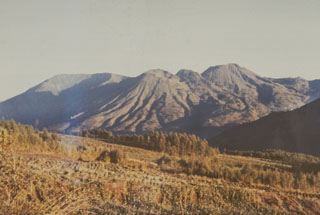Report on Dieng Volcanic Complex (Indonesia) — December 1981
Scientific Event Alert Network Bulletin, vol. 6, no. 12 (December 1981)
Managing Editor: Lindsay McClelland.
Dieng Volcanic Complex (Indonesia) Earthquake swarm, but little change in thermal activity
Please cite this report as:
Global Volcanism Program, 1981. Report on Dieng Volcanic Complex (Indonesia) (McClelland, L., ed.). Scientific Event Alert Network Bulletin, 6:12. Smithsonian Institution. https://doi.org/10.5479/si.GVP.SEAN198112-263200
Dieng Volcanic Complex
Indonesia
7.2°S, 109.879°E; summit elev. 2565 m
All times are local (unless otherwise noted)
On 17 November an area of the Dieng volcanic complex with a history of poisonous gas emission experienced an MM 2-3 felt earthquake. A tripartite electromagnetic seismometer located the shocks in a zone of fractures and gas emission 1-2 km E of Batur. Newspapers and radio broadcasts reported that 3-12 seismic events were recorded during each of the 10 days ending 6 December. However, the number of events began to decrease in early December, and seismicity was continuing to decline as of the 17th.
There were no indications of volcanic activity. The poisonous gas content of vapor sampled at several known emission sites had not changed more than 15% from previous measurements. The temperature of the pool of boiling mud at Sileri cone and the thermal feature Sikidang, a few kilometers E of the zone, remained unchanged at 90°C. Government officials issued an alert, but removed it after receiving a VSI report.
Geological Summary. The Dieng plateau in the highlands of central Java is renowned both for the variety of its volcanic scenery and as a sacred area housing Java's oldest Hindu temples, dating back to the 9th century CE. The Dieng Volcanic Complex consists of multiple stratovolcanoes and more than 20 small Pleistocene-to-Holocene craters and cones over a 6 x 14 km area. Prahu stratovolcano was truncated by a large Pleistocene caldera, which was subsequently filled by a series of cones, lava domes, and craters, many containing lakes. Lava flows cover much of the plateau, but observed activity has been restricted to minor phreatic eruptions. Gas emissions are a hazard at several craters and have caused fatalities. There are abundant thermal features and high heat flow across the area.
Information Contacts: A. Sudradjat, VSI; Jakarta DRS.

